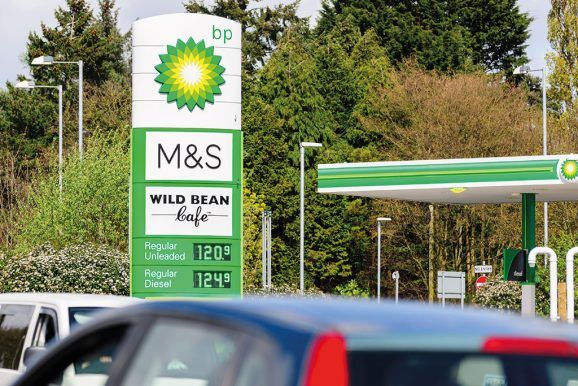How convenience retail can up its game

John E. Kaye

Oliver Shaw of Kalibrate analyses what UK convenience stores and service stations can do to build on the customer increase resulting from the recent health crisis
During the Covid-19 pandemic, the value placed on convenience was at its highest as accessible local retail outlets became essential services. Changing routines disrupted how people worked and relaxed, and, as a result, spent.
However, the recent easing of restrictions has seen consumer confidence return to high streets and shopping centres. This poses challenges for convenience stores, as location influences how and when a consumer visits your store, which consequently impacts what consumers are attracted to in-store. Now retailers must again re-evaluate where the most lucrative locations are.
Because ultimately, how can local convenience businesses prosper in such a competitive and changing retail environment, which continues to be impacted by the wider economic pressures and supply disruption?
Keeping up with ever-changing consumer habits
Shopping habits are heavily influenced by the need for convenience, and consumers are willing to pay a higher price than they would at a large grocery store in exchange for that ease.
The convenience and grocery sector makes up for 90% of Britain’s food shopping, and it became essential to consumers when lockdowns made local shopping more prominent. What’s more, when millions were working from home every day, they were spending less time in city centres and developing different travel habits.
But with a return to normal – or at least this new normal – for convenience operators, the competitive landscape has shifted as other retailers have adapted to meet changing consumer needs. Organisations that want to stay ahead have access to vast quantities of data to understand the impact of changing behaviour, from their own loyalty insight to mobility data to sophisticated demographics. In fact, there has never been more data available than there is today.
Reshaping retail
While we have seen levels of normality return, public transport use is still below pre-pandemic levels. The rise of home or hybrid working models has seen consumers change their day-to-day routines – and many of these shifts are permanent.
Consumers have recognised the value of their time, and convenience and fuel retailers must respond to this need by adapting their offerings. Convenience stores (c-stores) and service stations must become places where people want to shop. Well maintained toilets are a must. Wi-fi accessibility for those visiting service stations. Then for c-stores, parcel pick up and drop off points need to be provided. A well-stocked chilled foods section is essential – a diverse selection of food offerings, that goes beyond sandwiches and takeaway coffee, can help to differentiate from the competition.
Then there is a new concept taking convenience shopping by storm with the likes of Amazon Go leading the industry. Tapping into shoppers’ daily need for convenience, retailers like Amazon and Tesco are implementing technology that uses a combination of cameras, sensors, computer vision techniques, and deep learning to allow customers to shop and leave the store without queuing to pay.
Driving convenience
And of course, how c-stores and service station retailers apply convenience to drivers is key. Looking forward, as the United Kingdom lays out its plan to make all new cars and trucks electric by 2050, the £1bn investment to electrify our roads presents another opportunity to do this. A strategy that cracks the EV conundrum and understands changing consumer needs will be imperative. The likes of Waitrose and stores like Co-op and Nisa Local have already formed partnerships with EV charging companies to attract drivers willing to invest in EVs.
The appetite is there too – 41% of EV drivers want charging points at existing fuel stations and nearly three-in-five (59%) of drivers spend more money at shops or businesses that offer EV charging. Convenience stores that can equip charging points may stand to benefit from a variety of advantages, including direct revenue from customers, higher ROI and an enhanced reputation as a forward-thinking company.
Supercharging the service stations of the future
It is important to be realistic, of course. EV charging stations require capital investment, but the opportunity is significant given EV sales more than doubled in 2021.

Simply installing chargers at every service station or adding just one or two outside the local c-store isn’t the answer yet. It is critical to understand where to locate them, and when. A data-first approach will be paramount. To begin with, businesses need to use analytics to understand and identify the most advantageous areas for EV investment based on current and projected levels of EV adoption.
Now is an excellent time to evaluate your fuel retail offering and take steps to maximise the potential of your location, in relation to customers and where they live, work, and play. Understanding demand alongside situational characteristics and competitive intensity impacts is the difference between a successful, profitable site and a painful, costly misstep.
Planning ahead
The pandemic showed us the value of having a flourishing retail community close to home. Local hospitality businesses were an amazing example of a sector that developed by adding new services such as food and drink bundles and online home delivery, maintaining as close to “business as usual” as possible – all while remaining profitable.
But consumer habits and behaviours have changed. In some areas, we’ve reverted to pre-pandemic routines. In others, the return looks unlikely. Forecourts must adapt quickly by investing in an insight-driven approach, to understand their role in their customers’ new normal.
ABOUT THE AUTHOR

Further information
Sign up to The European Newsletter
RECENT ARTICLES
-
 The European's Luxury Report Supplement is out now
The European's Luxury Report Supplement is out now -
 This city is Hollywood’s Mediterranean playground — and now is the time to visit
This city is Hollywood’s Mediterranean playground — and now is the time to visit -
 ‘I was bullied into submission’: how Huw Montague Rendall fought back to become opera’s next superstar
‘I was bullied into submission’: how Huw Montague Rendall fought back to become opera’s next superstar -
 2026 is looking up: a happy new year written in the stars
2026 is looking up: a happy new year written in the stars -
 Birding tourism market set for rapid growth through 2032, report finds
Birding tourism market set for rapid growth through 2032, report finds -
 Book Review: A history of the world told by animals — and it changes everything
Book Review: A history of the world told by animals — and it changes everything -
 Make a list, check it twice: expert tips for running Christmas in hospitality
Make a list, check it twice: expert tips for running Christmas in hospitality -
 December night sky guide: what to look for and where to find it
December night sky guide: what to look for and where to find it -
 Four Seasons Yachts reveals overhauled 2027 Mediterranean programme
Four Seasons Yachts reveals overhauled 2027 Mediterranean programme -
 The European road test: MG’s new electric flagships, the Cyberster and IM5
The European road test: MG’s new electric flagships, the Cyberster and IM5 -
 Historic motorsport confronts its energy future
Historic motorsport confronts its energy future -
 Protecting the world’s wild places: Dr Catherine Barnard on how local partnerships drive global conservation
Protecting the world’s wild places: Dr Catherine Barnard on how local partnerships drive global conservation -
 We ditched Cornwall for North Norfolk — and found a coast Britain forgot
We ditched Cornwall for North Norfolk — and found a coast Britain forgot -
 How BGG became the powerhouse behind some of the world’s biggest wellness brands
How BGG became the powerhouse behind some of the world’s biggest wellness brands -
 Exploring France’s wildest delta: Julian Doyle on the trail of white horses, black bulls and the hidden history of the Camargue
Exploring France’s wildest delta: Julian Doyle on the trail of white horses, black bulls and the hidden history of the Camargue -
 “Embarrassment is killing men”: leading cancer expert warns stigma hides deadly truth about male breast cancer
“Embarrassment is killing men”: leading cancer expert warns stigma hides deadly truth about male breast cancer -
 Diving into… Key West, Florida
Diving into… Key West, Florida -
 Nick Mason leads celebrity line-up at London Motor Week
Nick Mason leads celebrity line-up at London Motor Week -
 The simple checks every man should do for breast cancer
The simple checks every man should do for breast cancer -
 Concerto Copenhagen marks Danish EU presidency with gala at Bozar
Concerto Copenhagen marks Danish EU presidency with gala at Bozar -
 What effective addiction treatment looks like today
What effective addiction treatment looks like today -
 NOMOS Glashütte named Germany’s best sports watch brand 2025
NOMOS Glashütte named Germany’s best sports watch brand 2025 -
 Stars, supermoons and shooting fireballs: why November’s sky is unmissable
Stars, supermoons and shooting fireballs: why November’s sky is unmissable -
 “Derbyshire is both a treasure and a responsibility” — William Glossop on the New Heritage Shell Guide
“Derbyshire is both a treasure and a responsibility” — William Glossop on the New Heritage Shell Guide -
 Inside the Maldives’ most exclusive getaway
Inside the Maldives’ most exclusive getaway


























